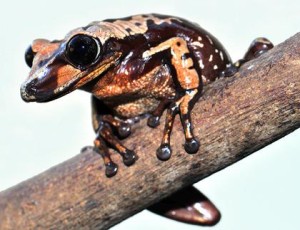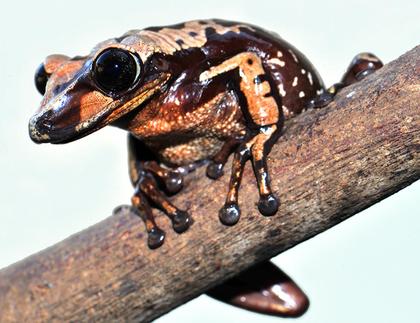
Carlos Jared, of the Instituto Butantan in São Paulo, Brazil, was collecting specimens of the frog Corythomantis greeningi in the field when his hand was injured by a spine on the amphibian’s head. Intense pain spread up his arm and persisted for five hours.
“That clued us in that there was something a bit different about this frog,” says Jared’s colleague Edmund Brodie Jr., of Utah State Univ., in an interview with R&D Magazine,Bioscience Technology’s sister publication. “Many, many frog species are poisonous, and those repel predators if a predator eats them, bites or chews them. The difference with a venomous animal is they can use those skin toxins to inflict the toxins onto another animal … without being chewed up or eaten.”
But the researchers are calling for a reclassification of C. greeningi and Aparasphenodon brunoi, Brazilian hylid frogs, as venomous. Their work is described in Current Biology.
“This is a whole new level of anti-predator defense than we’ve ever imagined,” Brodie says.
Brodie describes C. greeningi as an amphibian that dwells in dry desert areas. Surrounding vegetation is limited to cacti. The frog habitats crevices in the rocks, only exposing their heads. “When a person or a predator reaches in to grab the frog, they grab the head and that’s where the spines are,” he says.
A. brunoi populate the Brazilian rain forests and live in bromeliad plants. Similar to C. greeningi, A. brunoi positions itself in the plant’s axil with its head exposed.
According to the researchers, both species’ skulls consist of numerous bony spines, which are enlarged in the nasal, jaw and occipital regions. More prominent spines are located near the nostril and upper lip area, associated with concentrations of mucous and granular glands.
The frogs exhibit the ability to turn and rotate their heads, a behavior unusual for frogs, according to Brodie. “So if you grasp one of these frogs by the body, it can turn the head and start jabbing into your hand with the spines and at that point you drop it immediately.”
Startlingly, the venom exuded by A. brunoi is 25 times more potent than the venom of the deadlyBothrops pitviper. Though the delivery system is inferior to a pitvipers’, the researchers warn venom seeping into a wound from the spine could be dangerous to a would-be predator.
“With any project like this, there are more questions raised than answered,” says Brodie. “We’re working to more fully characterize the skin secretions and look histologically at those glands to see what’s the different about these frogs.”








